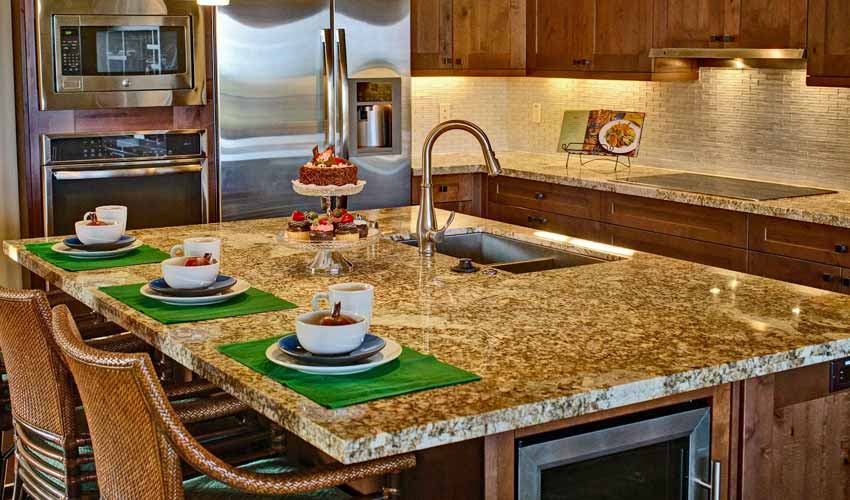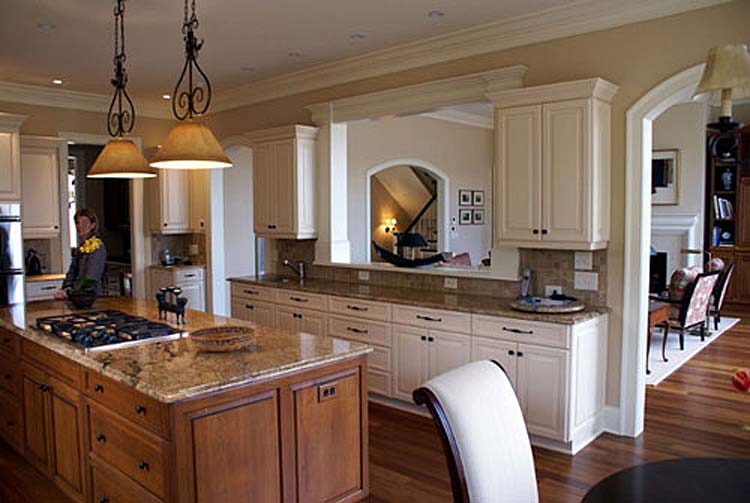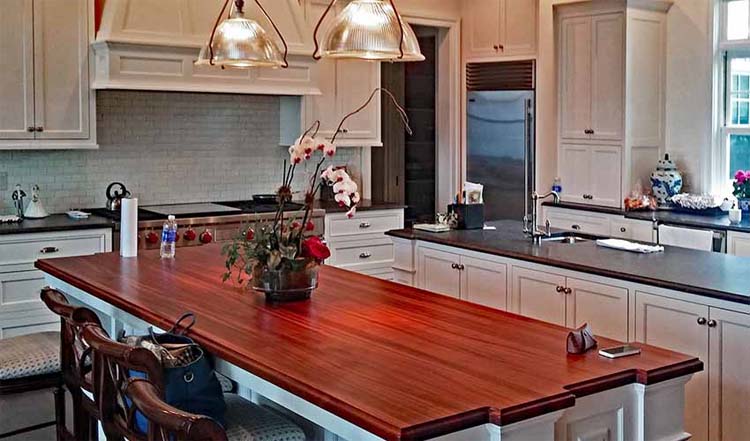Kitchen Countertops Can Make a Kitchen Beautiful

There are many types of kitchen countertops to choose from. It’s not always easy to decide what’s best for you. The high-end market practically demands granite or solid surface tops. But your budget and personal preference may make plastic laminate a better choice. Maybe a solid surface or even wood might suit your kitchen. To help you decide, let’s take a look at the various kitchen countertops and the pros and cons of each.
Plastic Laminate Countertops
Plastic Laminate Countertops are by far the most economical option for kitchen countertops. They may not have the social status and market appeal of granite and solid surface countertops, but plastic laminates, like Formica, WilsonArt, and Nevamar are reasonably priced, very durable, easy to care for, and can look quite nice. Plastic laminate is available in many colors and patterns, including realistic stone and wood patterns.
Premium laminates have special textured finishes and finishes that add visual depth, much like polished stone. You can even get patterns that are unique to laminates and give a special look you can’t find anywhere else. Of course, the special finish laminates come at an additional cost. But even the top of the price range of plastic laminate will be below the cost of solid surfaces or stone.
Plastic laminates are easy to clean and because they are non-porous, they will not stain under normal use. The shortcomings of plastic laminate kitchen countertops are that they can scratch and knives will cut them fairly easily. Their biggest shortcoming is they are not heat resistant. You cannot put a hot pan directly on them or you’ll damage them. One tip. The plastic laminate choices with matte finishes will hide day to day abrasions.
Glossy surfaces will show even minor scratches. If you put a very hot pot on a plastic laminate countertop, it will almost certainly be damaged. If the edges are not sealed properly and water can get to the substrate (the particle board or plywood below the surface) the countertop will swell and be ruined. However, these issues are easily managed with trivets and making sure edges are sealed.
Improving the Appearance of Plastic Laminate Countertops
Plastic laminates can be constructed with special edge details to enhance their appearance. Standard square edges will show a dark line where the horizontal surface joins the vertical surface. This is not very noticeable in dark colors or patterns, but it can be disconcerting with light colors. Now, mitered edges are available that can hide the dark line. Rolled edges and edges that are slightly raised to prevent spills from running over the edge of the countertop can be molded in during fabrication.
These rolled edges have no seam and therefore show no dark line. For a bit more money, you can have a wood edge added. This can elevate the aesthetics of ordinary plastic laminate and give a designer look to the kitchen countertop for a small additional cost. I find that integrated wood edges can look great with leather-look or stone-look plastic laminate.
Another limitation with plastic laminate kitchen countertops is they usually cannot have undermount sinks installed in them. A surface mount sink with a rim that sits on top of the countertop surface must be used to keep the exposed edge of the substrate beneath the plastic laminate from being exposed to water. But even with these limitations, plastic laminate kitchen countertops give you a lot for your money and will look good for a long time.
Solid Surface Countertops
A big step up in cost from plastic laminate tops are Solid Surface Countertops. Solid surface materials such as Corian are made from acrylic polymers. The color you see on the top runs all the way through the countertop and is not simply a layer on the surface like in plastic laminate kitchen countertops.
For many years, Corian was the only choice for solid surfaces. And the color options were essentially non-existent. But now that DuPont’s patents have run out and there are competitors in the marketplace, solid surfaces are available in many colors and patterns.
Solid surfaces have a distinct advantage over laminates in that seams are virtually invisible. Plus, small scratches can be sanded and buffed out. Sinks can be installed as surface mount units or undermounts.
But one sink option that is unique to solid surfaces is a sink made of the very same polymer material as the countertop that can be “welded” to the countertop creating a seamless connection. This removes all crevices for dirt to accumulate and is an appealing feature.
Solid Surface Countertops Can’t Stand the Heat
Solid surfaces are not heat resistant and hot pans can melt and burn them. The integral polymer sinks can crack if extremely hot water is poured into them. These are not extreme worries and a modicum of care will prevent these problems from occurring. But you will have to treat solid surface kitchen countertops differently than some of the other options.
As I said, solid surfaces are a significant step up in cost from laminates. An in between option is a plywood and solid surface composite. This type of countertop consists of a plywood backing with a moderately thick solid surface layer on top. By reducing the amount of polymer material needed because the solid polymer layer is thinner, the cost of the kitchen countertops can be reduced while still providing the look and feel of a thicker solid surface.
Granite Countertops
Granite Countertops are the stylish and functional choice in high-end kitchens. You can get granite in a wide range of colors and patterns, all created by Mother Nature herself. Granite is virtually indestructible and will look good for a very long time with minimal care.

Granite is available in two and three centimeter thicknesses, but three centimeter is the popular choice for kitchen countertops. Two centimeter is often used for bathroom vanity tops.
You may automatically think of a shiny, polished appearance when you visualize granite countertops. But granite is also available in a honed finish that is smooth, but not shiny, and it’s available in “flamed” and “leathered” finishes that have a textured surface. The flamed or leathered surfaces are still smooth enough to use for a kitchen countertop and can be cleaned easily. But they are irregular enough that it would be difficult to write your shopping list out neatly on a piece of paper on top of it. Because the honed and flamed surfaces are not yet widely used, i.e., seen everywhere, they can give your kitchen a very distinctive look.
Granite is non-porous. It will not stain under normal use, although I have seen a bottle of olive oil leave a ring after sitting in the same spot for several days. Granite does have minute voids in the surface and because of that, many people recommend sealing it to close these irregularities and keep food and bacteria out. Sealing a granite countertop is not hard. It is simply a matter of cleaning the top well and wiping on a liquid sealant. This takes just a few minutes and only needs to be done annually.
Granite Countertop Benefits
Benefits of granite kitchen countertops are that it is tough, heat resistant and beautiful. It can be fitted with undermount sinks and can also have integral drainage grooves cut into the surface to let the section of the countertop adjacent to the sink act as a drainboard.
Granite countertops are more expensive than plastic laminates, but the cost has gotten much better in recent years. The actual cost will depend on the color and pattern of the granite you select, not on the physical quality of the stone. Types of granite that are plentiful are competitively priced. Granites that are scarce are more expensive. But don’t overlook granite for your kitchen countertops just because you think it’s too expensive for you. Price out some of the more plentiful varieties and you might be surprised to find granite can fit your budget. If it does, the market value of your house will be enhanced and the small added cost may be worth it.
Some granites have patterns that are consistent throughout the slab. Others have “movement” or veining that can vary from one slab to another. If you select one of the granite types with movement, it is wise to preview and select the exact slabs for your kitchen at the granite slab supplier’s warehouse and work with the fabricator to determine how the countertop will be cut from the slab to get the veining and feature colors in the best place in your kitchen countertop.
Marble and Limestone
Marble and Limestone Countertops are other choices for stone tops. These are beautiful, but very hard to live with. They have many of the same virtues of granite, such as the ability to have undermount sinks and the continuous color through the thickness of the slab so edge details will not show seams.
But marble and limestone are very soft and porous stones. Mild acids like orange juice will etch the surface and dull the polished shine. Spilled liquids, like red wine, will soak in and stain the stone. Scratches will happen easily. I recommend against marble and limestone for kitchen countertops because of those shortcomings. You will be disappointed in them in a few short years.
One solid stone that has similar visual characteristics to marble is quartzite. This is not to be confused with quartz solid-surface countertops that are made of stone chips bonded into a resin. Quartzite is a solid stone from a quarry. Quartzite is a hard stone and does not have the maintenance problems true marble has. It is a good choice if you are looking for a marble type of appearance.
Quartz Composite Countertops
Quartz Composites are another kitchen countertop option. These are a man-made product, like the other solid surfaces. But quartz composites are made of over 90% crushed quartz, a very hard stone and one of the minerals in granite. The quartz stones are bonded together with resins to form what is called an “engineered stone.” It is cut into slabs and polished. Quartz countertops will give you many of the same benefits of granite, such as heat and chemical resistance and the ability to install undermount sinks.
Quartz tops come in many colors and styles. The main visual difference between these and granite is the color and pattern in a quartz countertop is much more even and uniform than granite. This is either a benefit or shortcoming, depending on your tastes. Newer offerings from the quartz top manufacturers have more movement than they have in the past. In some cases, it is hard to know if a top is quarried stone or an engineered stone.
My clients often think that quartz tops and even solid surface countertops will be less expensive than granite, but this is not true. Quartz and Corian can be more expensive than the more plentiful and better priced granites. So, don’t select these countertops for a cost savings. Select them if they are the look you want and if you like their functional advantages.
Porcelain
One other recently available countertop choice is porcelain. Porcelain had come to dominate the tile market due to its good looks, durability, and reasonable priding. Now, large slabs (effectively giant tiles) of porcelain are being produced. These have the realistic stone images printed into them like the porcelain tiles. They are not low priced but could become so as time goes by. They are extremely durable and actually harder on the Mohs Scale of Mineral Hardness than granite. And they are resistant to heat. Porcelain slabs, such as Dekton, can be mitered together at the edges allowing extra thick edges and waterfall ends to be made.
Edge Details
Edge Detail Choices for granite, marble, limestone, quartz tops and solid surface tops will be similar. You have the choice of square, slightly rounded, bull-nosed, and shaped or ogee edges with any of them.
Concrete Countertops have grown in popularity. They are not like the concrete in your sidewalk. This kind of concrete is smooth and can be formed and colored in many different ways. Unique items like bits of glass and sea shells can be imbedded in the concrete to give the kitchen countertop a personal and distinctive appearance.
Concrete countertops are sealed and polished to give an attractive and easily maintained finish. But even though concrete is an inexpensive material, concrete countertops are not inexpensive. Because of the labor that goes into making and finishing a concrete top, the cost can quickly exceed the cost of even a high-priced granite top.
Wood Countertops
Wood Countertops are possible. These can be built from many different species of wood and will give an elegant, warm look to your kitchen. But they require more maintenance than stone or plastic laminates. Wood tops need to be oiled annually to keep them sealed and prevent splitting. This is not a hard task, just like sealing granite or other stones. But wood tops cannot be exposed to water without incurring damage. They also can be damaged by very high heat.

Incidentally, there is one manufacturer of wood countertops that has a proprietary finish that allows for contact with water without damage. Grothouse Lumber has a finish they call Durata that works well and will let you have wood kitchen countertops with an undermount sink without water damage problems. Wood tops cost about the same as the higher priced granite choices, but the distinctive and warm look of the wood may be worth it.
Tile Countertops
Tile Countertops can be a three-way compromise between cost, usefulness, and appearance. Granite, ceramic, and porcelain tiles can be used to construct a countertop. The stone tiles are much less expensive than full slabs and will give you the benefits of heat resistance and the appearance of granite for less money. Ceramic tile and porcelain tile will do the same.
Tile countertops have grout between the tiles and the grout can be a cleaning challenge. If you are planning on using tile for your kitchen countertop, look at large tiles to reduce the number of grout joints and then be sure to use an epoxy grout. These kinds of grouts are very resistant to stains.
There are other exotic choices, such as slate, soapstone, and slabs made from recycled content that can be used for kitchen countertops. Each one comes with benefits and shortcomings. No single one of these is the answer to everyone’s needs. So do a little research and get samples of your prime candidates. Be sure to choose the other parts of your kitchen at the same time. It’s important to select the complete palette of countertop, backsplash, cabinets, cabinet hardware, kitchen flooring, and paint simultaneously to make sure you have everything working in harmony.
I hope this information is helpful to you. You might want to get yourself a copy of my best-seller, Designing Your Perfect House. It is chockfull of valuable tips and advice that will save you many times the cost of the book on your house building or remodeling project. You might also like The Well-Centered Home: Simple Steps to Increase Mindfulness, Self-Awareness, and Happiness Where You Live. It will show you how to make your home a happy place.

